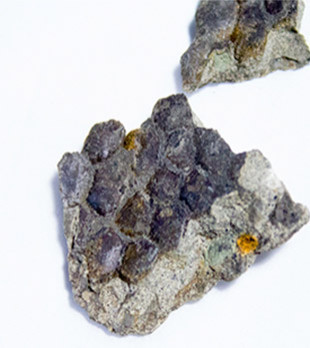What Color Were The Dinosaurs? Particle Accelerator Experiment Should Provide Clues

Dinosaur fossils aren’t usually examined with particle accelerators, but Canadian scientists have a very good reason to stick a piece of preserved hadrosaur skin in one.
A piece of skin that was once attached to a duck-billed dinosaur in the Late Cretaceous and found millions of years later in Alberta will soon be loaded into the Canadian Light Source synchrotron. If successful, the experiment could paint a more detailed portrait of a hadrosaur than ever before.
By shooting an infrared beam at the dinosaur skin, University of Regina physicist Mauricio Barbi hopes to get a good look at melanosomes, which are microscopic cellular pigment-containing structures. With a view of those tiny features, Barbi and his colleagues might be able to figure out what color the hadrosaur’s skin was.
“If we are able to observe the melanosomes and their shape, it will be the first time pigments have been identified in the skin of a dinosaur," Barbi said in a statement. “We have no real idea what the skin looks like. Is it green, blue, orange … There has been research that proved the colour of some dinosaur feathers, but never skin.”
When the infrared beam from the accelerator bounces off of the fossilized skin, the chemical bonds between various compounds in the sample will vibrate at different frequencies. By examining that vibration fingerprint, Barbi and the others should be able to spot the signature of melanosomes and other components of the skin.
The experiment may also reveal what the hadrosaur ate, and provide some clues as to why its skin has stayed nearly intact for millions of years.
“What’s not clear is what happened to this dinosaur and how it died,” Barbi said. “There is something special about this fossil and the area where it was found, and I am going to find out what it is.”
But this wouldn’t be the first time researchers have deduced a dinosaur’s color palette. In 2010, Chinese and British scientists determined that a diminutive dinosaur called Sinosinopteryx had a chestnut-colored mohawk of feathers on its tail, cut with white stripes. They published their results in the journal Nature.
The scientists took a really close look at a well-preserved Sinosinopteryx fossil and found structures they said are nearly identical to the feathers of modern birds. One tail portion had structures “stuffed” with melanosomes that once produced a reddish tint, along with regions that would have been white.
Later that year, another team of scientists provided a color map of a different feathered dinosaur: Anchiornis huxleyi. Writing in the journal Science, they painted a portrait using the melanosomes found in the dinosaur’s feathers: a red crown, a dark grey body with red speckles on the face and white feathers with spangled black patterns.
“We might be able to start painting a picture in color of what these things looked like,” Ohio University paleontologist Lawrence M. Witmer told the New York Times in 2010.
Now, thanks to this latest effort in Canada, we may be able to color in yet another dinosaur.
© Copyright IBTimes 2024. All rights reserved.





















